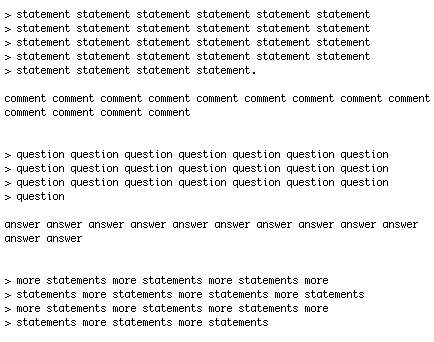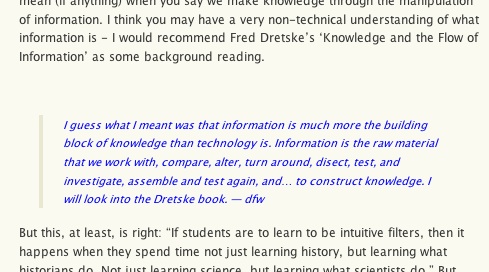When you reply to someone’s e-mail message, and you are answering a number of questions or commenting on a number of points in the e-mail,  it is considered a courtesy to include the original mail message, and to insert your answers or comments just beneath the questions and statements that they address. The text of the original e-mail is usually indented, with each line preceded with an angle bracket (>).
it is considered a courtesy to include the original mail message, and to insert your answers or comments just beneath the questions and statements that they address. The text of the original e-mail is usually indented, with each line preceded with an angle bracket (>).
Embedding your comments and answers into the original message turns it in to a conversation that can more easily be followed by your busy colleague.
E-mail is a private conversation, meant as an exchange of information. Carefully clipping, separating, and interrupting statements and questions with comments and answers serves to improve that conversation. Blogs are different, as Stephen Downes reminded me yesterday.
 Blogging is much more about publishing. Although there are certainly important elements of conversation wrapped around it, a weblog is usually intended for a broader audience, as are its comments. As such, blogging usually involves more thought and care in composing and formatting the text. A blog entry and its comments are more refined information products, and to insert a comment within someones posted blog or comment is an act of violating the integrity of their writing — and this is what I did yesterday morning to Stephen Downes comment on my blog (Is All Information Knowledge?).
Blogging is much more about publishing. Although there are certainly important elements of conversation wrapped around it, a weblog is usually intended for a broader audience, as are its comments. As such, blogging usually involves more thought and care in composing and formatting the text. A blog entry and its comments are more refined information products, and to insert a comment within someones posted blog or comment is an act of violating the integrity of their writing — and this is what I did yesterday morning to Stephen Downes comment on my blog (Is All Information Knowledge?).
It was certainly not my intent to violate his verbal space, only to expedite the conversation. But blogging being what it is — I did alter the integrity of his writing.
I apologize.
..and am thankful for the learning experience — though not an altogether pleasant one. I let Stephen Downes get under my skin, probably because I hadn’t had breakfast yet. Aside from our exchanges, it’s a pretty good conversation.
My point in talking about information is to suggest that we, as technology advocates, spend more time thinking about this new, vibrant, and dynamic information landscape, and less thinking about its technical conduit. I just think that asking teachers to integrate networked, digital, and dynamic information/conversation into their classrooms could be more productive than asking them to integrate technology.
technorati tags:warlick, technology, education, literacy, ethics, blogging, stephendownes
Blogged with Flock
